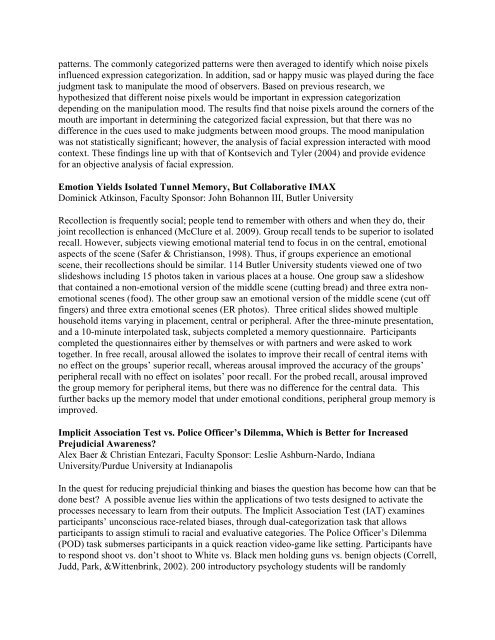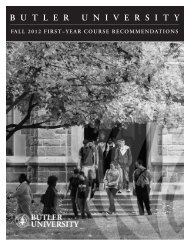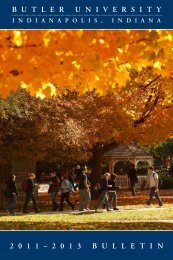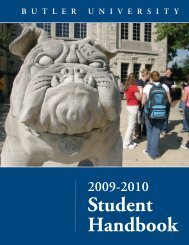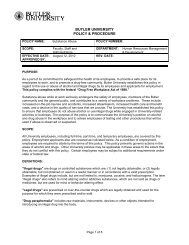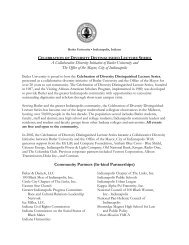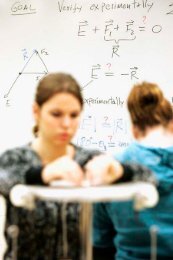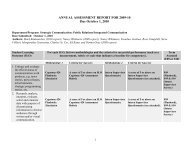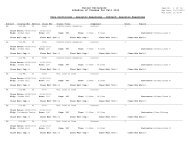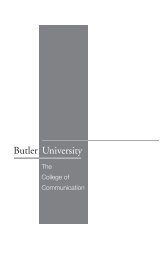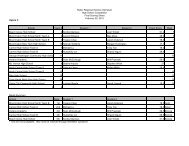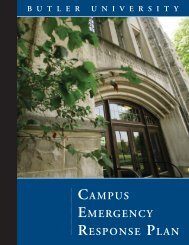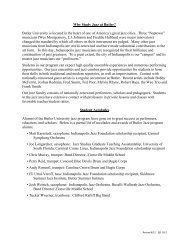Anthropology - Butler University
Anthropology - Butler University
Anthropology - Butler University
You also want an ePaper? Increase the reach of your titles
YUMPU automatically turns print PDFs into web optimized ePapers that Google loves.
patterns. The commonly categorized patterns were then averaged to identify which noise pixels<br />
influenced expression categorization. In addition, sad or happy music was played during the face<br />
judgment task to manipulate the mood of observers. Based on previous research, we<br />
hypothesized that different noise pixels would be important in expression categorization<br />
depending on the manipulation mood. The results find that noise pixels around the corners of the<br />
mouth are important in determining the categorized facial expression, but that there was no<br />
difference in the cues used to make judgments between mood groups. The mood manipulation<br />
was not statistically significant; however, the analysis of facial expression interacted with mood<br />
context. These findings line up with that of Kontsevich and Tyler (2004) and provide evidence<br />
for an objective analysis of facial expression.<br />
Emotion Yields Isolated Tunnel Memory, But Collaborative IMAX<br />
Dominick Atkinson, Faculty Sponsor: John Bohannon III, <strong>Butler</strong> <strong>University</strong><br />
Recollection is frequently social; people tend to remember with others and when they do, their<br />
joint recollection is enhanced (McClure et al. 2009). Group recall tends to be superior to isolated<br />
recall. However, subjects viewing emotional material tend to focus in on the central, emotional<br />
aspects of the scene (Safer & Christianson, 1998). Thus, if groups experience an emotional<br />
scene, their recollections should be similar. 114 <strong>Butler</strong> <strong>University</strong> students viewed one of two<br />
slideshows including 15 photos taken in various places at a house. One group saw a slideshow<br />
that contained a non-emotional version of the middle scene (cutting bread) and three extra nonemotional<br />
scenes (food). The other group saw an emotional version of the middle scene (cut off<br />
fingers) and three extra emotional scenes (ER photos). Three critical slides showed multiple<br />
household items varying in placement, central or peripheral. After the three-minute presentation,<br />
and a 10-minute interpolated task, subjects completed a memory questionnaire. Participants<br />
completed the questionnaires either by themselves or with partners and were asked to work<br />
together. In free recall, arousal allowed the isolates to improve their recall of central items with<br />
no effect on the groups’ superior recall, whereas arousal improved the accuracy of the groups’<br />
peripheral recall with no effect on isolates’ poor recall. For the probed recall, arousal improved<br />
the group memory for peripheral items, but there was no difference for the central data. This<br />
further backs up the memory model that under emotional conditions, peripheral group memory is<br />
improved.<br />
Implicit Association Test vs. Police Officer’s Dilemma, Which is Better for Increased<br />
Prejudicial Awareness?<br />
Alex Baer & Christian Entezari, Faculty Sponsor: Leslie Ashburn-Nardo, Indiana<br />
<strong>University</strong>/Purdue <strong>University</strong> at Indianapolis<br />
In the quest for reducing prejudicial thinking and biases the question has become how can that be<br />
done best? A possible avenue lies within the applications of two tests designed to activate the<br />
processes necessary to learn from their outputs. The Implicit Association Test (IAT) examines<br />
participants’ unconscious race-related biases, through dual-categorization task that allows<br />
participants to assign stimuli to racial and evaluative categories. The Police Officer’s Dilemma<br />
(POD) task submerses participants in a quick reaction video-game like setting. Participants have<br />
to respond shoot vs. don’t shoot to White vs. Black men holding guns vs. benign objects (Correll,<br />
Judd, Park, &Wittenbrink, 2002). 200 introductory psychology students will be randomly


